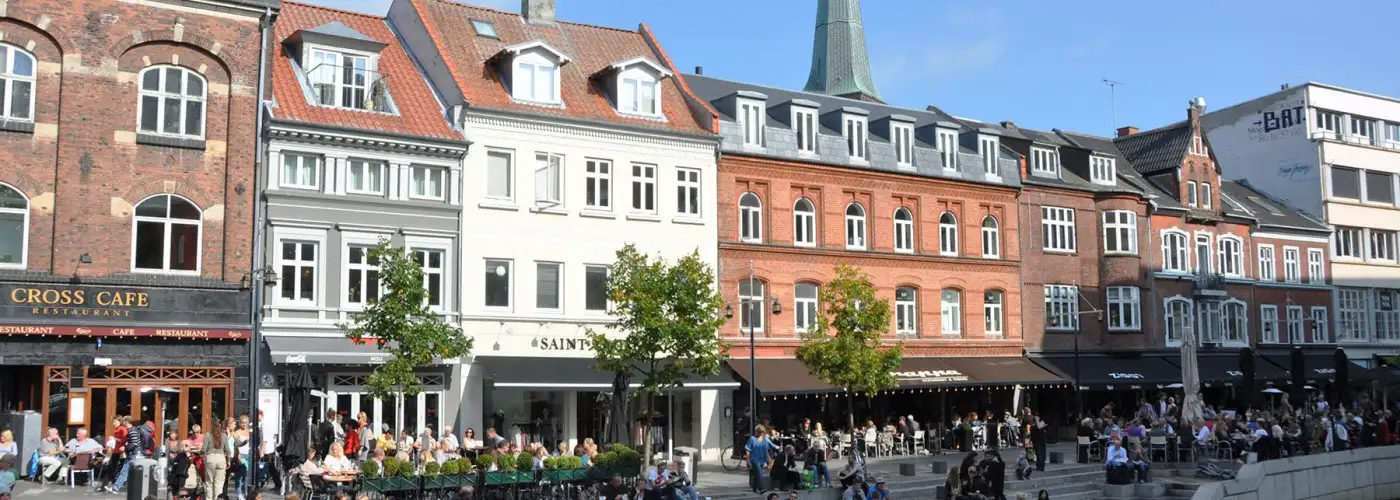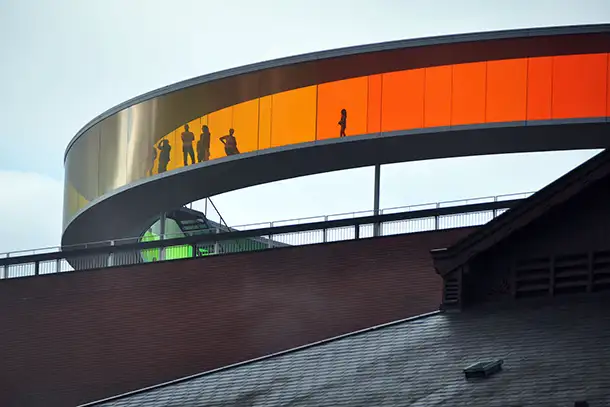Aarhus, Denmark’s second-largest city, calls itself the “World’s Smallest Big City.” I’d argue it’s more like the world’s biggest little town: easy to handle and easy to like. A pleasant three-hour train ride from Copenhagen, Aarhus is well worth a stop.
Aarhus is the lively cultural hub of Jutland, the part of Denmark that juts up from Germany—a land of windswept sandy beaches, inviting lakes, and fortified old towns. It’s also one of the oldest cities in Scandinavia. When its Viking founders settled here in the eighth century, they were attracted to its strategic location, where a river hits the sea. The navigable river meant the Vikings could easily run their ships inland if a hostile attack came from the open waters.
Today, Aarhus bustles with a lively port, an important university, a bursting-with-life pedestrian boulevard, and an adorable old quarter filled with people living well. This “second city” enjoys a friendly competition with Copenhagen, whose sophisticates sniff that’s there’s no need for intercity rail connections in Denmark because there’s only one city—theirs. But modern Aarhus is elbowing its way into the itineraries of tourists with some notable attractions and a thriving street scene.
The Aarhus Art Museum—called ARoS—has been around for years, but it’s become a must-see sight lately, thanks to a new contemporary building and a curatorial staff who have a knack for making cutting-edge art accessible and fun. One of the biggest draws is a work by Olafur Eliasson, “Your Rainbow Panorama”—a 360-degree walkway that perches on the rooftop like a rainbow-colored halo. My favorite piece in the collection is one very big “Boy” by the Australian artist Ron Mueck. This superrealistic crouching figure, nearly 16 feet tall, always stops me in my tracks.
If modern art isn’t your thing, Aarhus has more traditional fare, including a fine open-air folk museum known as Den Gamle By (The Old Town). With 75 historic buildings carefully moved here from throughout Denmark, it gives visitors the best possible look at Danish urban life in decades past. Don’t be too shy to open doors or poke into seemingly abandoned courtyards—you’ll likely find a chatty docent inside, dressed in period attire and living life as in the bygone days: cooking over an open fire, chopping firewood, or baking bread.
You can travel even farther back in time at the Viking Museum. In 1960, when a new bank was being built in downtown Aarhus, local archaeologists had a chance to excavate the site. Working their way down through the layers of time, they uncovered a section of the long-ago Viking town, including the remains of houses, wells, streets, tools, and pottery. Most curiously, they discovered the headless skeleton of a man—he’s possibly Aarhus’s oldest murder victim. The artifacts found are now on display in the cellar of that very bank (Nordea Bank, free).
Aarhus has another famous corpse—the Grauballe Man, the world’s best-preserved “bog man.” Archaeologists think he was a sacrificial victim, killed some 2,300 years ago and tossed into a peaty swamp. Because of the oxygen-free, acidic environment, he looks like a fellow half his age. He’s displayed on the outskirts of town at the Moesgard prehistory museum, which will be opening a new building this fall.
The city also has a fascinating exhibit about life under Nazi rule during World War II. Aarhus’s police station, used by the Nazi occupiers for their Gestapo headquarters from 1940 until 1945, now tells the story of the Danish resistance. You’ll learn about heroic acts of sabotage, hear how guns were dropped by England in the night, and see underground newspapers that kept occupied Danes connected and in the know.
But there’s more to Aarhus than museums. As you wander the streets, the city just entertains. The higgledy-piggledy Latin Quarter, encompassing six or eight square blocks, is the oldest quarter, built in the late 14th century after the city knocked down the old Viking fortifications. This area is great for shopping, cafes, and strolling. Its streets have historical names like Klostergade (Convent Street), Volden (The Rampart), and Badstuegade (Bath Street)—from the time when the riffraff visited public bathhouses for their annual “Christmas bath” (finer folk bathed monthly).
Another fun people zone stretches alongside the town’s canal (Aboulevarden). In the 1930s, Aarhus covered over its river to make a new road, but in the 1980s, locals decided to remove it. They artfully canalized the river, creating a trendy avenue that’s now the town’s place to see and be seen. Lined with modern eateries, the street stays lively even after the short Danish summer fades away. With its vibrant mix of youthful energy and respect for the past, Aarhus is a dynamic place. As the locals like to say, “Aarhus” is Danish for “progress.”
Rick Steves (www.ricksteves.com) writes European travel guidebooks and hosts travel shows on public television and public radio. Email him at [email protected] and follow his blog on Facebook.
(Photos: Cameron Hewitt)
You Might Also Like:
- Why Locals (and You) Will Love Copenhagen This Year
- Oslo, City of Art and Design
- 10 Places in Europe You Never Thought You Could Afford
We hand-pick everything we recommend and select items through testing and reviews. Some products are sent to us free of charge with no incentive to offer a favorable review. We offer our unbiased opinions and do not accept compensation to review products. All items are in stock and prices are accurate at the time of publication. If you buy something through our links, we may earn a commission.
Related
Top Fares From
Today's Top Travel Deals
Brought to you by ShermansTravel
Kenya: 14-Night Tour, Incl. Tanzania &...
smarTours
 vacation
$7125+
vacation
$7125+
7-Night Caribbean Round-Trip Cruise From Orlando:...
Norwegian Cruise Line
 cruise
$739+
cruise
$739+
Ohio: Daily Car Rentals from Cincinnati
85OFF.com
 Car Rental
$19+
Car Rental
$19+





